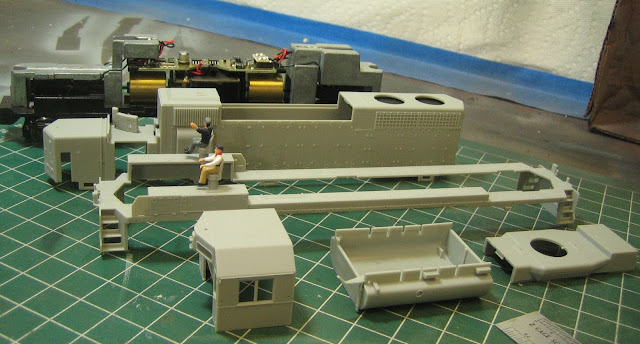Well, that "plan" didn' quite work out, as there was a fellow named Rick just a couple of tables down, and among other things, he had a few engines out for sale as well. He had two undecorated Atlas GP38's, new in the box, but unused. I bought one, but forced myself not to buy the second one. I had a rough idea what I would do with one, but not two.
The JSSX is small, and well suited for four axle engines. Since I like to think that my fictional shortline has limited finances, it often leases older used power, and what JSSX owns itself is pretty well the same type of thing. I'd have to turn this GP38 into something that would fit right in with this theme.
Here's the GP 38 sitting on the workbench, the way it looked when I took it out of the box just about 12 days ago:
And broken down into it's basic components for painting:
From rrpicturearchives.net, this photo is one that got my attention and I used this as the inspiration for my project. I didn't do any of the engine's modifications to the model, just used it to go by: This photo of SQVR 345 is by Randy Davis. The prototype locomotive is apparently working for a living in Shelbyville, Tenessee.
I initially sprayed my model with Modelflex reefer grey, to which I had added just a few drops of blue. I thought my eyes were kind of picking up just a hint of blue to the grey body colour. The sill and walkways were sprayed with Modelflex weathered black. I chose to leave off the large numbers at the back end of the locomotive. I don't think I'll put any numbers on the sides at all (claiming modellers license here). As for the exhaust stack coverings, I'll have to try to make them out of some brass sheet or something at some time in the future. That is, whenever I have some suitable material.
Here, the model sits outside the JSSX engine shed. The basic painting is completed, and my shortline's lettering applied beneath the cab windows in place of the SQVR letters:
Below, the first layer of rust weathering has been applied. It was far easier to do the rust streaking with the handrails not yet installed.
Here we go with the model about as complete as it's going to get, at least for now. In addition to the rust spots and streaking, I've added in plenty of grime streaking as well. I've chosen to put on the front plow that came with the model, although the prototype doesn't have this style.
The handrails were painted with Modelflex RBOX yellow first, which was way too bright, so I went over-top of that with some pale yellow acrylic craft paint. The grilles and screens received multiple coats of Vallejo black wash to darken them in so they would stand out nicely against the grey body.
I think that the white dashed side sill markers really set the whole thing off:
I like the rust ring around the fan:
All in all, this was done over the course of about 12 days work here, start to finish. I really like the grey and black scheme. The dark drabness of it fits in well with the mood I'm trying to evoke on the JSSX.
I'll add on those exhaust covers or spark arrestors (whichever they're called) sometime, and it needs a radio antenna too. I want to see if I can get a pale yellow paint pen to colour the edges of the steps as well. Ditch lights would be good too. And now that I think of it, I kind of wish I had that 2nd GP 38 that Rick was selling.






















